Models of values education and moral education in the era of the fourth industrial revolution
The history of values education and moral
education over the past 40 years closely parallels
American social history during the same period.
To oversimplify, the Fifties were the decade of
conformity, McCarthyism, and “the organization
man.” 1 Since there appeared to be a consensus
among parents, religious, and society regarding
values and morality, values education during
this period consisted of the traditional methods
of inculcating and modeling. Schools took their
role in values education for granted. Children were
exhorted to be prompt, neat, and polite; to work
hard succeed; to respect other’s property - in short,
to behave themselves. And that is as far as values
education and moral education went.
Then came the turbulent Sixties and Seventies,
when traditional roles and values were seriously
questioned - and in many cases rejected - by the
younger generation. The status of blacks, women,
students, and other minorities changed dramatically,
in one of the fastest social revolutions in human
history. New attitudes toward and experimentation
with human sexuality, religion, career options,
lifestyles, and personal values were widespread.
The common thread underlying all these social
changes could be summarized in the popular
slogan, “Power to the people.” Minority groups and
individuals increasingly assumed greater decisionmaking power and control over their lives. 2
As might be expected, values education and
moral education began to reflect these changes in
society. Instead of simply inculcating and modeling
values, educators were now encouraged to help
students clarify their own values, learn higher
levels of moral reasoning, and learn the skills
of value analysis. 3 Educators were counseled to
avoid imposing their own values and moral on
their students - because, the argument went, in an
increasingly pluralistic society, whose values are the
“right values”? A better course seemed to be to help
young people learn the skills of moral reasoning
and responsible decision making that would enable
them to lead more personally satisfying and socially
constructive lives.
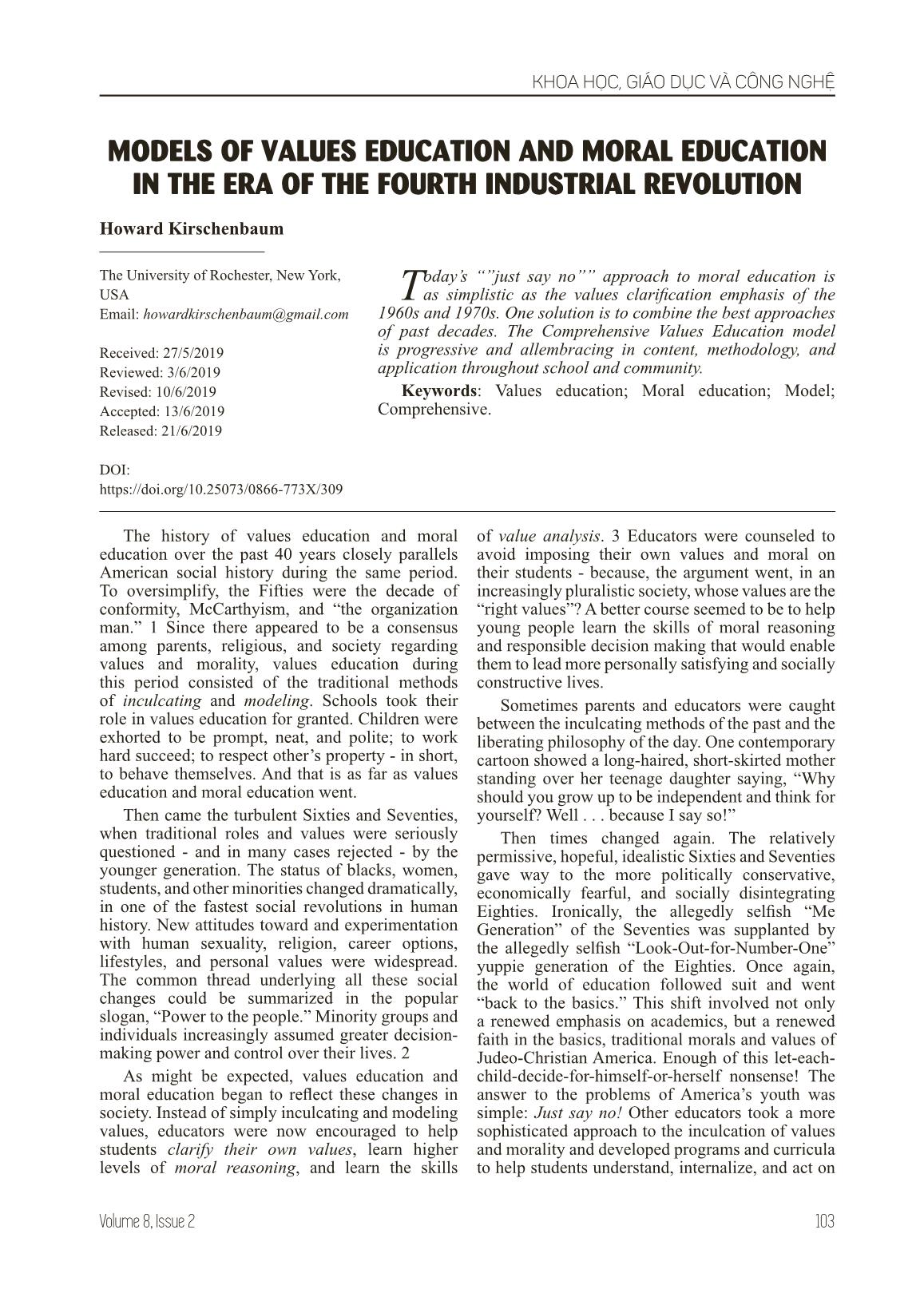
Trang 1
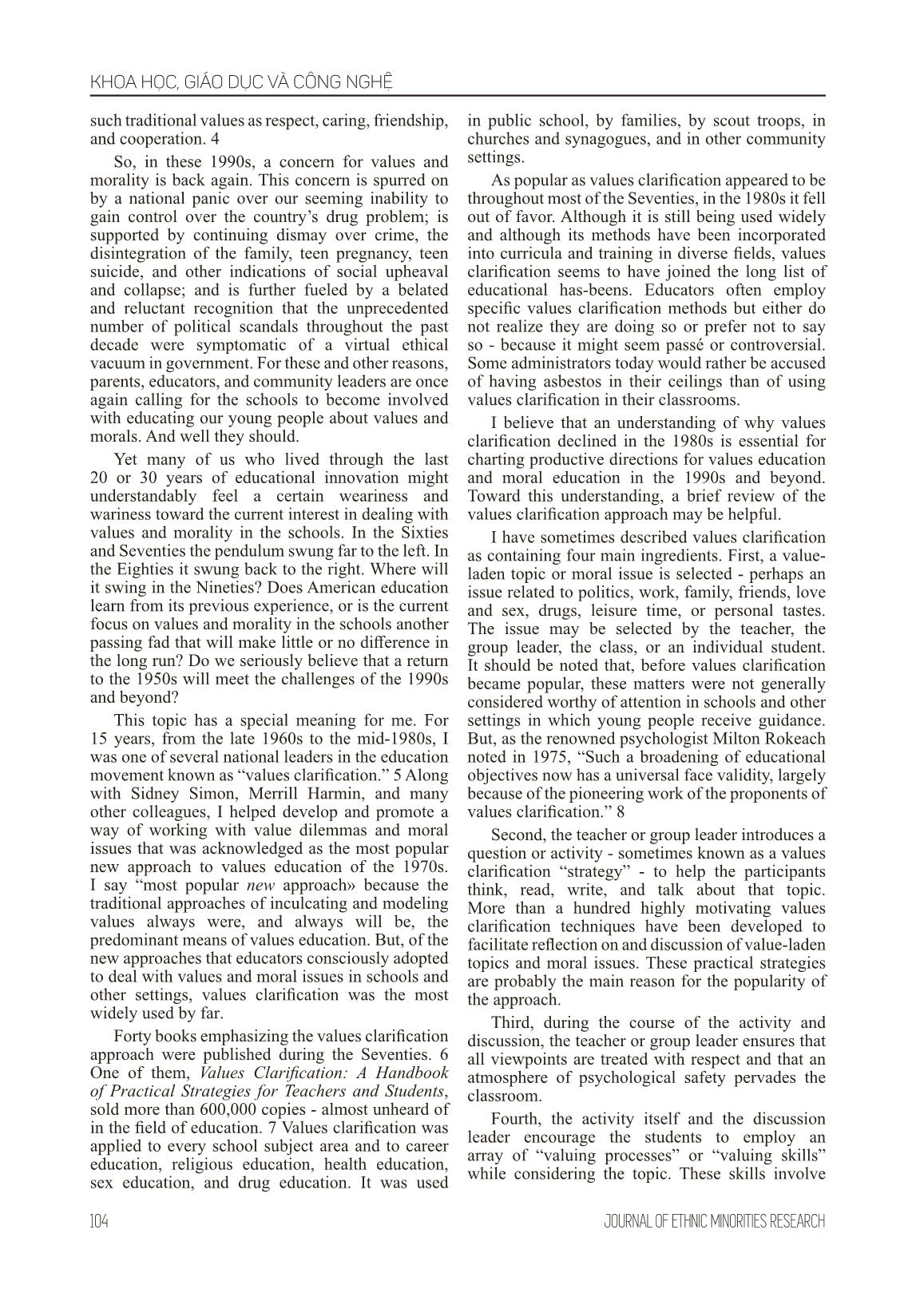
Trang 2
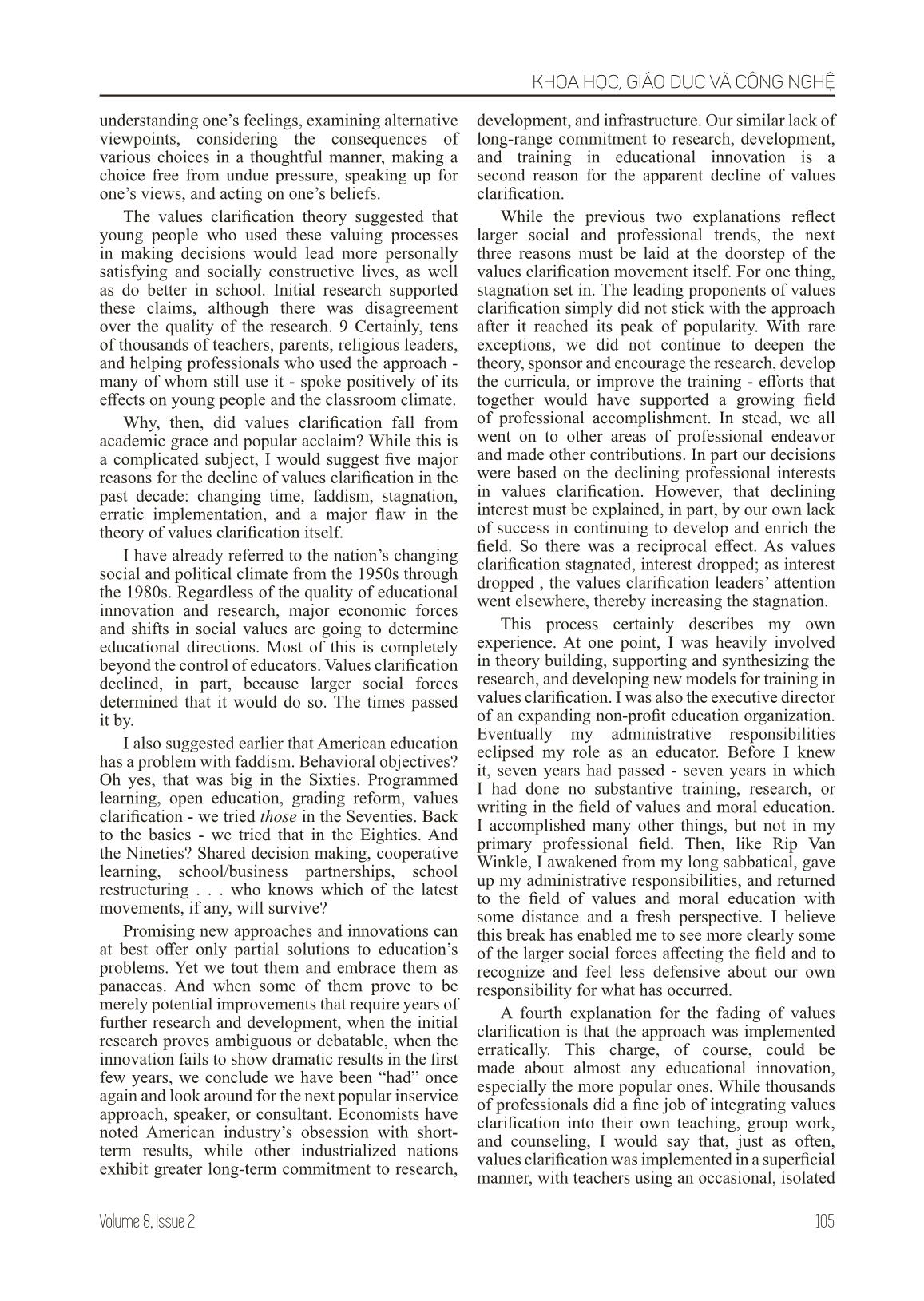
Trang 3
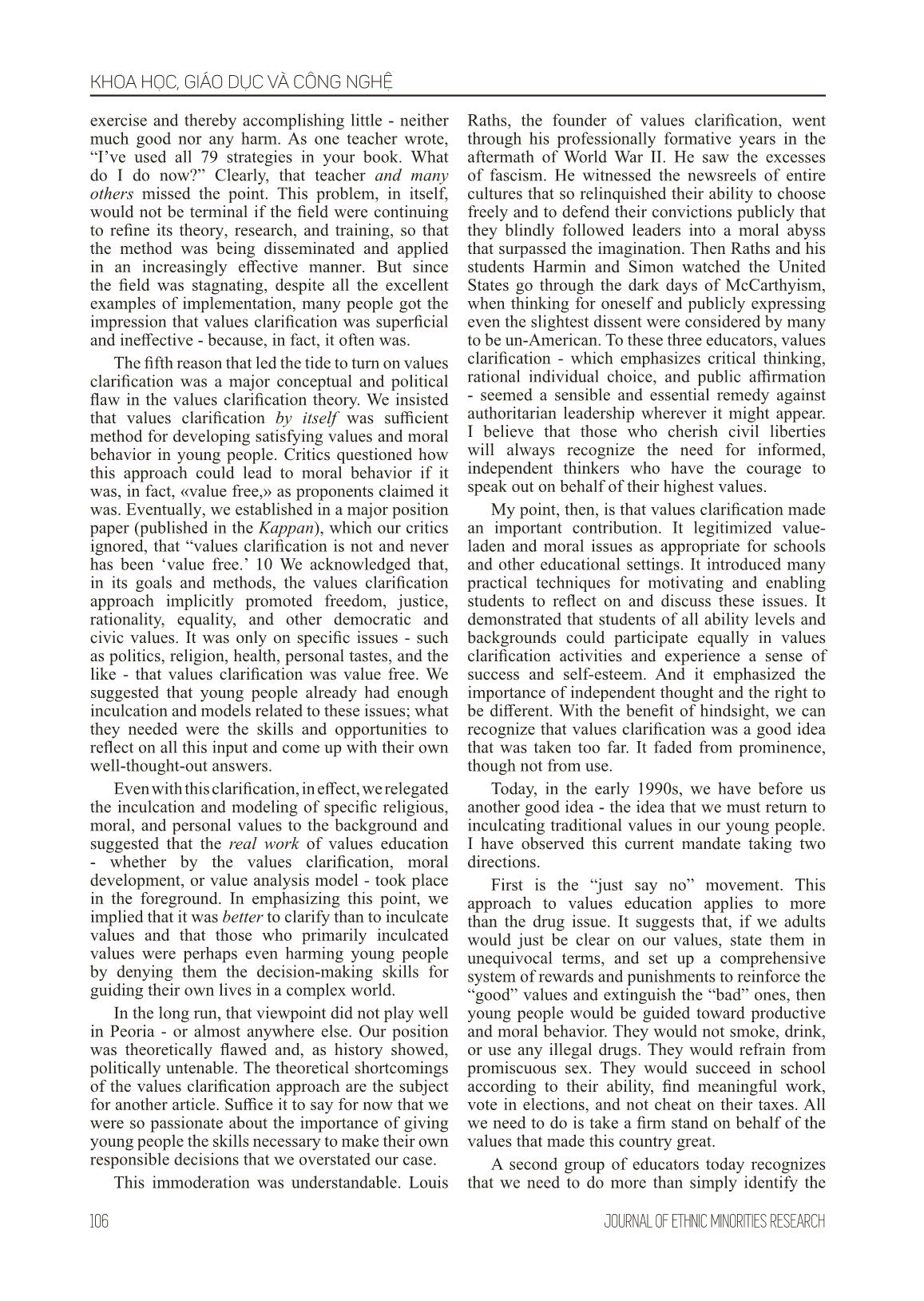
Trang 4
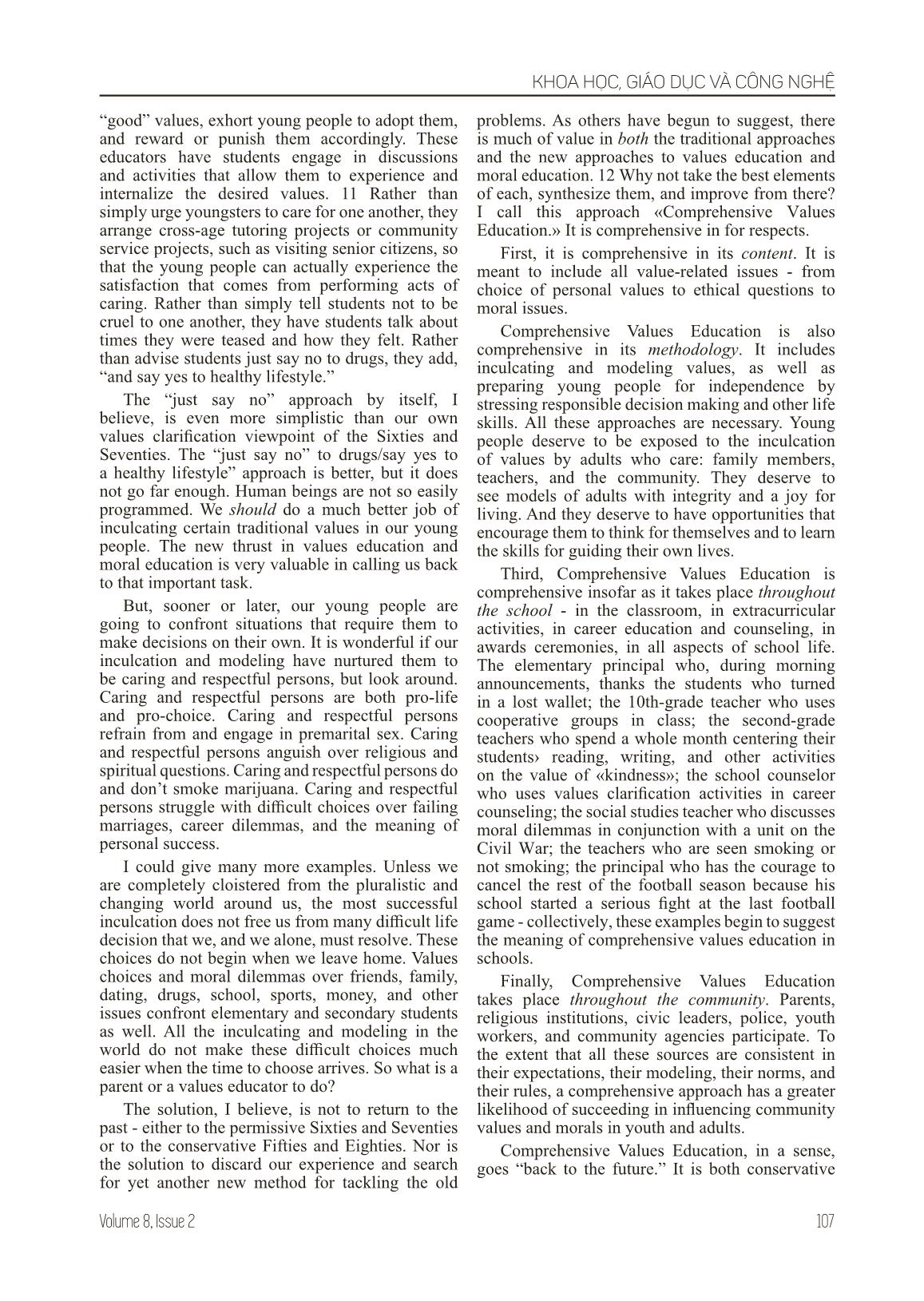
Trang 5
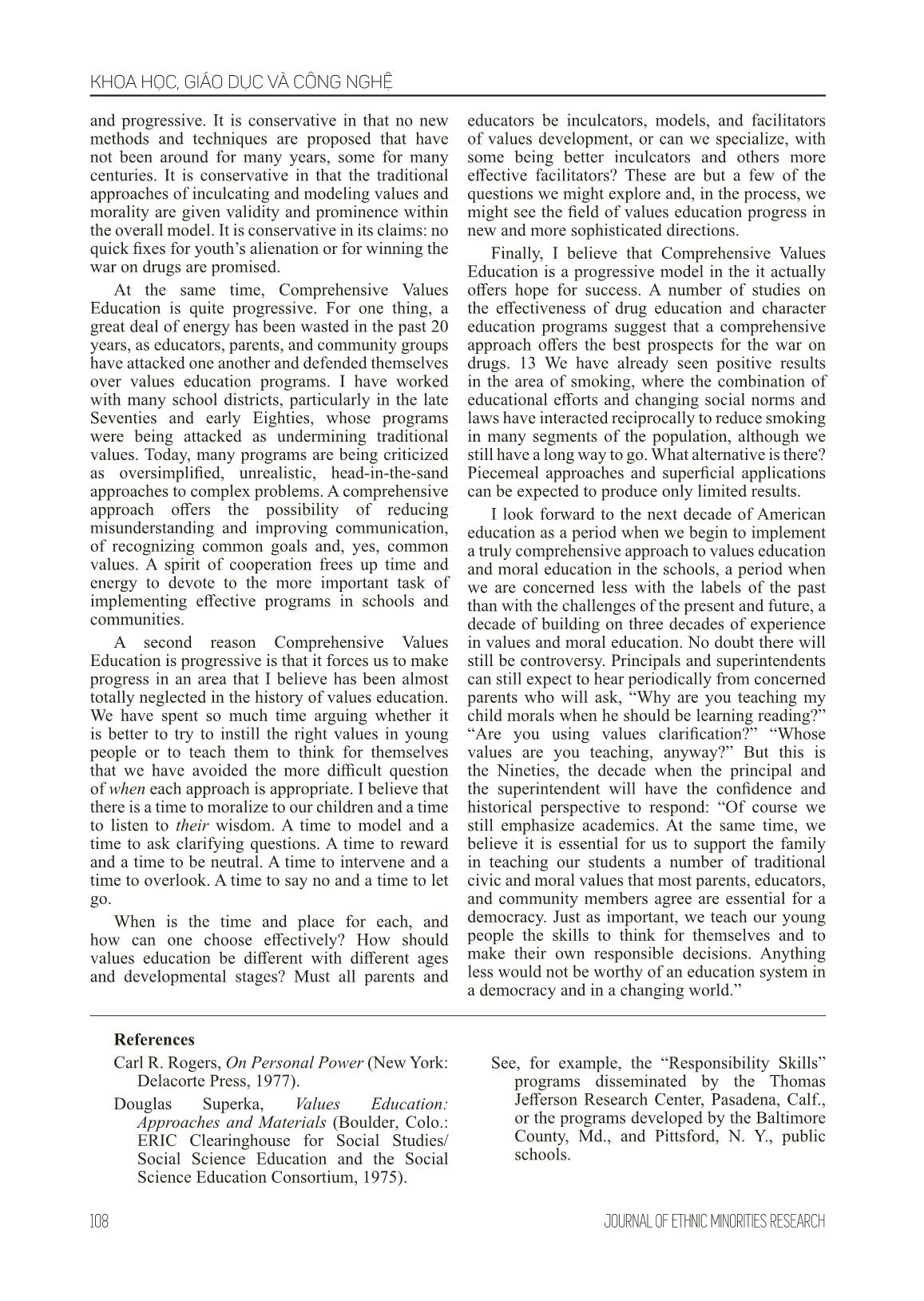
Trang 6

Trang 7
Tóm tắt nội dung tài liệu: Models of values education and moral education in the era of the fourth industrial revolution
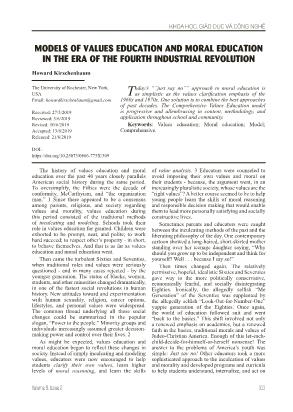
hey would not smoke, drink, or use any illegal drugs. They would refrain from promiscuous sex. They would succeed in school according to their ability, find meaningful work, vote in elections, and not cheat on their taxes. All we need to do is take a firm stand on behalf of the values that made this country great. A second group of educators today recognizes that we need to do more than simply identify the KHOA HỌC, GIÁO DỤC VÀ CÔNG NGHỆ 107Volume 8, Issue 2 “good” values, exhort young people to adopt them, and reward or punish them accordingly. These educators have students engage in discussions and activities that allow them to experience and internalize the desired values. 11 Rather than simply urge youngsters to care for one another, they arrange cross-age tutoring projects or community service projects, such as visiting senior citizens, so that the young people can actually experience the satisfaction that comes from performing acts of caring. Rather than simply tell students not to be cruel to one another, they have students talk about times they were teased and how they felt. Rather than advise students just say no to drugs, they add, “and say yes to healthy lifestyle.” The “just say no” approach by itself, I believe, is even more simplistic than our own values clarification viewpoint of the Sixties and Seventies. The “just say no” to drugs/say yes to a healthy lifestyle” approach is better, but it does not go far enough. Human beings are not so easily programmed. We should do a much better job of inculcating certain traditional values in our young people. The new thrust in values education and moral education is very valuable in calling us back to that important task. But, sooner or later, our young people are going to confront situations that require them to make decisions on their own. It is wonderful if our inculcation and modeling have nurtured them to be caring and respectful persons, but look around. Caring and respectful persons are both pro-life and pro-choice. Caring and respectful persons refrain from and engage in premarital sex. Caring and respectful persons anguish over religious and spiritual questions. Caring and respectful persons do and don’t smoke marijuana. Caring and respectful persons struggle with difficult choices over failing marriages, career dilemmas, and the meaning of personal success. I could give many more examples. Unless we are completely cloistered from the pluralistic and changing world around us, the most successful inculcation does not free us from many difficult life decision that we, and we alone, must resolve. These choices do not begin when we leave home. Values choices and moral dilemmas over friends, family, dating, drugs, school, sports, money, and other issues confront elementary and secondary students as well. All the inculcating and modeling in the world do not make these difficult choices much easier when the time to choose arrives. So what is a parent or a values educator to do? The solution, I believe, is not to return to the past - either to the permissive Sixties and Seventies or to the conservative Fifties and Eighties. Nor is the solution to discard our experience and search for yet another new method for tackling the old problems. As others have begun to suggest, there is much of value in both the traditional approaches and the new approaches to values education and moral education. 12 Why not take the best elements of each, synthesize them, and improve from there? I call this approach «Comprehensive Values Education.» It is comprehensive in for respects. First, it is comprehensive in its content. It is meant to include all value-related issues - from choice of personal values to ethical questions to moral issues. Comprehensive Values Education is also comprehensive in its methodology. It includes inculcating and modeling values, as well as preparing young people for independence by stressing responsible decision making and other life skills. All these approaches are necessary. Young people deserve to be exposed to the inculcation of values by adults who care: family members, teachers, and the community. They deserve to see models of adults with integrity and a joy for living. And they deserve to have opportunities that encourage them to think for themselves and to learn the skills for guiding their own lives. Third, Comprehensive Values Education is comprehensive insofar as it takes place throughout the school - in the classroom, in extracurricular activities, in career education and counseling, in awards ceremonies, in all aspects of school life. The elementary principal who, during morning announcements, thanks the students who turned in a lost wallet; the 10th-grade teacher who uses cooperative groups in class; the second-grade teachers who spend a whole month centering their students› reading, writing, and other activities on the value of «kindness»; the school counselor who uses values clarification activities in career counseling; the social studies teacher who discusses moral dilemmas in conjunction with a unit on the Civil War; the teachers who are seen smoking or not smoking; the principal who has the courage to cancel the rest of the football season because his school started a serious fight at the last football game - collectively, these examples begin to suggest the meaning of comprehensive values education in schools. Finally, Comprehensive Values Education takes place throughout the community. Parents, religious institutions, civic leaders, police, youth workers, and community agencies participate. To the extent that all these sources are consistent in their expectations, their modeling, their norms, and their rules, a comprehensive approach has a greater likelihood of succeeding in influencing community values and morals in youth and adults. Comprehensive Values Education, in a sense, goes “back to the future.” It is both conservative KHOA HỌC, GIÁO DỤC VÀ CÔNG NGHỆ 108 JOURNAL OF ETHNIC MINORITIES RESEARCH and progressive. It is conservative in that no new methods and techniques are proposed that have not been around for many years, some for many centuries. It is conservative in that the traditional approaches of inculcating and modeling values and morality are given validity and prominence within the overall model. It is conservative in its claims: no quick fixes for youth’s alienation or for winning the war on drugs are promised. At the same time, Comprehensive Values Education is quite progressive. For one thing, a great deal of energy has been wasted in the past 20 years, as educators, parents, and community groups have attacked one another and defended themselves over values education programs. I have worked with many school districts, particularly in the late Seventies and early Eighties, whose programs were being attacked as undermining traditional values. Today, many programs are being criticized as oversimplified, unrealistic, head-in-the-sand approaches to complex problems. A comprehensive approach offers the possibility of reducing misunderstanding and improving communication, of recognizing common goals and, yes, common values. A spirit of cooperation frees up time and energy to devote to the more important task of implementing effective programs in schools and communities. A second reason Comprehensive Values Education is progressive is that it forces us to make progress in an area that I believe has been almost totally neglected in the history of values education. We have spent so much time arguing whether it is better to try to instill the right values in young people or to teach them to think for themselves that we have avoided the more difficult question of when each approach is appropriate. I believe that there is a time to moralize to our children and a time to listen to their wisdom. A time to model and a time to ask clarifying questions. A time to reward and a time to be neutral. A time to intervene and a time to overlook. A time to say no and a time to let go. When is the time and place for each, and how can one choose effectively? How should values education be different with different ages and developmental stages? Must all parents and educators be inculcators, models, and facilitators of values development, or can we specialize, with some being better inculcators and others more effective facilitators? These are but a few of the questions we might explore and, in the process, we might see the field of values education progress in new and more sophisticated directions. Finally, I believe that Comprehensive Values Education is a progressive model in the it actually offers hope for success. A number of studies on the effectiveness of drug education and character education programs suggest that a comprehensive approach offers the best prospects for the war on drugs. 13 We have already seen positive results in the area of smoking, where the combination of educational efforts and changing social norms and laws have interacted reciprocally to reduce smoking in many segments of the population, although we still have a long way to go. What alternative is there? Piecemeal approaches and superficial applications can be expected to produce only limited results. I look forward to the next decade of American education as a period when we begin to implement a truly comprehensive approach to values education and moral education in the schools, a period when we are concerned less with the labels of the past than with the challenges of the present and future, a decade of building on three decades of experience in values and moral education. No doubt there will still be controversy. Principals and superintendents can still expect to hear periodically from concerned parents who will ask, “Why are you teaching my child morals when he should be learning reading?” “Are you using values clarification?” “Whose values are you teaching, anyway?” But this is the Nineties, the decade when the principal and the superintendent will have the confidence and historical perspective to respond: “Of course we still emphasize academics. At the same time, we believe it is essential for us to support the family in teaching our students a number of traditional civic and moral values that most parents, educators, and community members agree are essential for a democracy. Just as important, we teach our young people the skills to think for themselves and to make their own responsible decisions. Anything less would not be worthy of an education system in a democracy and in a changing world.” References Carl R. Rogers, On Personal Power (New York: Delacorte Press, 1977). Douglas Superka, Values Education: Approaches and Materials (Boulder, Colo.: ERIC Clearinghouse for Social Studies/ Social Science Education and the Social Science Education Consortium, 1975). See, for example, the “Responsibility Skills” programs disseminated by the Thomas Jefferson Research Center, Pasadena, Calf., or the programs developed by the Baltimore County, Md., and Pittsford, N. Y., public schools. KHOA HỌC, GIÁO DỤC VÀ CÔNG NGHỆ 109Volume 8, Issue 2 NHỮNG MÔ HÌNH GIÁO DỤC GIÁ TRỊ VÀ GIÁO DỤC ĐẠO ĐỨC TRONG KỶ NGUYÊN CÁCH MẠNG CÔNG NGHIỆP LẦN THỨ TƯ Howard Kirschenbaum Trường Đại học Rochester, New York, Mỹ Email: howardkirschenbaum@gmail.com Ngày nhận bài: 27/5/2019 Ngày gửi phản biện: 3/6/2019 Ngày tác giả sửa: 10/6/2019 Ngày duyệt đăng: 13/6/2019 Ngày phát hành: 21/6/2019 DOI: https://doi.org/10.25073/0866-773X/309 Tóm tắt: Có thể nói ngay rằng không có cách tiếp cận giáo dục đạo đức nào là đơn giản như những giá trị đã được nhấn mạnh rõ nét từ những thập niên 1960 và 1970. Giải pháp là kết hợp các phương pháp tốt nhất trong những thập kỷ qua. Mô hình Giáo dục giá trị toàn diện là tiến bộ và liên quan đến nội dung, phương pháp và ứng dụng trong trường học và cộng đồng. Từ khóa: Giáo dục giá trị; Giáo dục đạo đức; Mô hình; Toàn diện. Louis B. Raths, Merrill Harmin, and Sidney B, Simon, Values and Teaching: Working with Values in the Classroom (Columbus, Ohio: Charles E. Merrill, 1966). Most are described in the annotated bibliography in Howard Kirschenbaum, Advanced Values Clarification (La Jolla, Calif.: University Associates, 1977). Sidney B. Simon, Leland W. Howe, and Howard Kirschenbaum, Values Clarification: A Handbook of Practical Strategies for Teachers and Students (New York: Hart Publishing, 1972; rev. ed., 1978; reprint, Hadley, Mass.: Values Associates, 1989). Milton Rokeach, “Toward a Philosophy of Values Education,” in John Meyer et al., eds., Values Education: Theory, Practice, Problems, Prospects (Waterloo, Ont.: Wilfred Laurier University Press, 1975). Howard Kirschenbaum, “Current Research in Values Clarification,” in idem, op. cit.; and Alan Lockwood, “What’s Wrong with Values Clarification?,” Social Education, May 1977, p. 399. Howard Kirschenbaum et al., “In Defense of Values Clarification,” Phi Delta Kappan, June 1977, pp. 743-46. Tom Lickona, “Educating the Moral Child,” Principal, November 1988, pp. 6-10; idem, Educating for Character: How Our Schools Can Teach Respect and Responsibility (New York: Bantam Books, 1992); and Jacques S. Benninga, Moral, Character, and Civic Education in the Elementary School (New York: Teachers College Press, 1991). See also references in note 4. Merrill Harmin, “Values Clarity, High Morality - Let’s Go for Both,” Educational Leadership, May 1988, pp. 24-30; idem, How to Plan a Program for Moral Education (Alexandria, Va.: Association for Supervision and Curriculum Development, 1990); and Panel on Moral Education, Moral Education in the Life of the School (Alexandria, Va.: Association for Supervision and Curriculum Development, 1988). V. Battistich et al., The Child Development Project: A Comprehensive Program for the Development of Prosocial Character (San Ramon, Calif.: Developmental Studies Center, 1988); Nancy Tobler, “Meta- Analysis of 143 Adolescent Drug Prevention Programs”, Journal of Drug Issues, vol. 16, 1986, pp. 537-67; John Swisher, What Works? (University Park: Pennsylvania State University/Pennsylvania Office of Substance Abuse Prevention, 1989); and Connie Young, «Alcohol, Drugs, Diving, and You: A Comprehensive Program to Prevent Adolescent Drinking, Drug Use, and Driving,» Journal of Alcohol and Drug Education, Winter 1991, pp.20-25. William H. Whyte, Jr., The Organization Man (New York: Simon & Schuster, 1956).
File đính kèm:
 models_of_values_education_and_moral_education_in_the_era_of.pdf
models_of_values_education_and_moral_education_in_the_era_of.pdf

